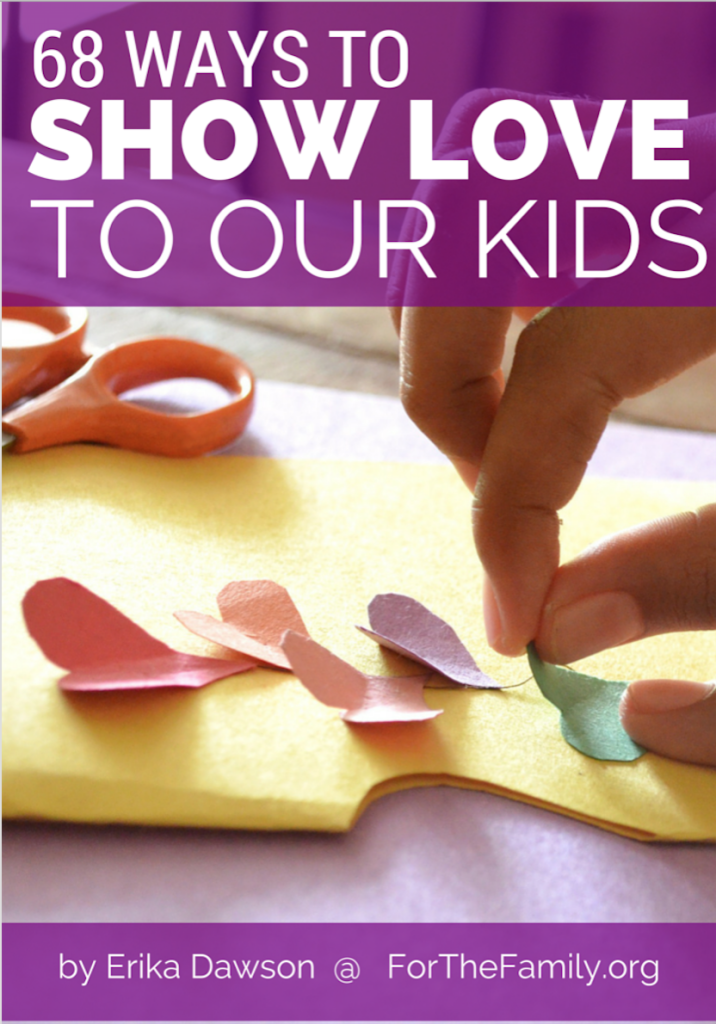68 Ways to Demonstrate Love to Your Kids
How well do you love your kids?
It’s a question that’s been simmering in my mind and heart this past year.
“I love you” falls from my mouth so easily and so often, but we all know that being loved and feeling loved can be two very different things.
Though we love our kids deeply, how can we convey the feeling of love? Love is more than a feeling and more than words. Love is a choice. It is an action. Love does something.
Saying “I love you” is easy, but showing it is a different story.
Here’s a simple place to start :: If I want to communicate love to my children, I need to be speaking their language!
Most people have heard of Gary Chapman’s best-selling book, The Five Love Languages, which introduced us to the idea that we all give and receive love in different ways. In case you need a reminder or a quick introduction, the five love languages are ::
- physical touch,
- words of affirmation,
- quality time,
- acts of service, and
- gifts.
While identifying your child’s love language might be relatively easy, actually speaking that language might be a little more challenging because though we might be familiar with each language, many of us don’t know how to speak those languages.
We may have grown up speaking “quality time” and need a crash course in how to speak love through “acts of service.” Others of us might be well-versed in “words of affirmation” but struggle with how to demonstrate love through giving “gifts.”
Like you, I often struggle to speak a second (third, fourth, or fifth) language! The language of love that comes naturally to me, isn’t necessarily the way my husband or kids feel most loved. So this is a quick cache of love language ideas, a translation guide, if you will, giving you some basic phrases to help you speak another love language.
Practical ways to love your child using their love language ::
Physical Touch ::
All kids need hugs. In fact, research shows that hugging makes you healthier! I’ve heard anywhere from 8 – 17 hugs a day is necessary. While this might seem easy with a baby or toddler, the number of hugs we give our older kids decreases greatly. Start with 8. How can you hug your child eight times per day?
It is important to remember, however, that kids whose love language is physical touch need more than just hugs! Use some of the suggestions below to communicate love to your child through appropriate physical touch.
- Hugs! (Shoot for at least eight a day — i.e.: when your child leaves, returns home, bedtime, etc.)
- Spend time rough housing
- Give back scratches
- Initiate high fives and fist bumps
- Give a foot or hand rub
- Tickle wars (but remember to watch for signs that the tickling is too much for your child)
- Hold your child while reading a book
- Pat your child on the head or play with her hair
- Twirl (imagine twirling your daughter while dancing with her)
- Rock together in a rocking chair
- Have piggyback or wheelbarrow races
- Play contact sports (basketball, football, soccer)
- Play tag, Twister, Duck, Duck Goose
- Snuggle up for a cartoon or movie
- Hold your child’s hand (natural opportunities for this are while praying, going for a walk, or sitting on the couch together)
- Create a special handshake, play hand clapping games, or have a thumb war
- Play airplane, flying your child around on your feet
- Put your hand on your child’s arm, shoulder, or around his neck when talking or walking
It is important to recognize that though a child’s love language might be physical touch at home, that same child might not be comfortable with physical affection or gentle touches from other family members, friends, or others. Respect your child’s boundaries!
Words of Affirmation ::
It might be easy to think that words of affirmation simply refer to praising a child, but when we “praise” a child, we are focusing on what a child does. Words of affirmation focus on who a child is and include encouraging words, words of affection, and words that give positive guidance.
- Write lunchbox notes
- Start a journal between the two of you
- Use encouraging words throughout the day
- Leave hidden notes around the house where your child might find them (on the bathroom mirror, as a bookmark in the book she’s reading, under his pillow, etc.)
- Say “I love you” a lot
- Compliment your child
- Have a special “Kid Night” (read all about it here)
- Speak positively about your child
- Create a special nickname or name of affection that only you (or you and your spouse) use with the child
- Speak positively about your child in front of other people
- Speak a blessing over your child
Quality Time ::
The years-old debate has been quality time versus quantity time but whichever the answer, in today’s smartphone addicted, multi-tasking families, the importance of quality time is evident. Quality time means giving your child focused, undivided attention; it is being present with your child.
- Run errands together.
- Plan a date night (here are some unique Daddy/daughter date nights).
- Give focused attention to each child. I’ve found that starting with 10 minutes of near-daily focused time with each child has been powerful in our family!
- Cook dinner or bake a treat one on one with that child.
- Look your child in the eye when you talk (not just when you’re disciplining or teaching).
- Tell stories. Share with your child about when you were his age or when you experienced something similar to your child.
- Plan a special outing or activity.
- Establish a daily family meal time.
- Sort through photo albums or your iPhoto library — share memories and stories together.
- Play a game together. (In our family, one of my kids loves playing Mario Kart with Mommy, for another, it’s Yahtzee!)
- Have a special bedtime routine. I know this is controversial for some, but I’ve always spent some time each night snuggling with the kids after our book & Bible time. It’s amazing the conversations we have when they are quieting down – and maybe avoiding sleep! I wouldn’t trade this time of any amount of productivity!
- Listen. With your eyes and your ears and your attention and your heart — listen when your child talks.
- DO your child’s favorite activity WITH him. If it’s playing make believe, watching a cartoon, playing at the park – don’t pick up your phone or read your book, engage with your child. Become a character, watch the show, or slide down the slide. Engage with your child.
- Create special traditions like Saturday morning pancakes, afternoon tea times, or once a month ice cream runs.
- Take selfies together — and laugh!
Gifts ::
“The grace of giving has little to do with the size and cost of the gift. It has everything to do with love” (Gary Chapman and Ross Campbell).
- Keep on hand a small stash of gifts your child might like ($5 iTunes gift card for a show or new app, his favorite candy, her favorite stickers, etc.).
- Make a special meal or your child’s favorite treat.
- Prepare or send small gifts when you are away.
- Sneak a surprise gift into your child’s lunchbox or under her pillow.
- Keep unique boxes or eye-catching wrapping paper on hand to wrap up the gifts – big or small.
- Choose gifts that are in line with your child’s interests. For example, if your child loves art, a gift could be as simple as new watercolors or more elaborate like an art class or a trip to the art museum.
- Give a gift that lasts (i.e.: a piece of jewelry, a game you can play over and over, a flower or bush that grows every year).
- Give them a meaningful gift of nature – flowers from the yard, sea glass you find on the beach, or a special item you find on your walk together. Rather than just handing it to the child, wrap it up and present it to the child the next day or on another occasion.
- Make something. What are your gifts? Use your drawing, writing, sewing, woodworking, craftiness, or musical ability to make or create something to give your child!
Acts of Service ::
- Practice sports or music or one of your child’s activities with them.
- Do the “thing” they’ve been asking – whether it’s fixing a bicycle or getting the toy from the top shelf, for a child whose primary love language is “acts of service,” responding in a timely manner is very important.
- Surprise your child with a clean room when they come in to clean it up!
- Instead of insisting your child “hurry,” bend down and help your child.
- Work together on a project.
- If your child is sick or tired, set up a special movie, game or book on the couch with extra pillows and blankets.
- Offer to drive your child to their outing, rather than seeking out a car pool friend.
- Respond quickly. Consider the need, of course, but for children whose love language is acts of service, respond in a timely manner instead of with multiple “in a minutes” and frequent “hang ons.”
- Do his chores occasionally!
- Pick the kids up on time.
- Make a special breakfast or treat.
- Help your child with her homework.
- Serve others together!
- Set up a foot soak for a tired child or after a sports practice.
- Serve your child breakfast (or snack) in bed.
Question for you ::
Do you know your child’s love language? How do your kids feel most loved? Which love language do you have the hardest time “speaking”?
Resources for you ::
- The 5 Love Languages of Children
- The 5 Love Languages of Teenagers
- A Perfect Pet for Peyton: A 5 Love Language Discovery Book
- The Love Dare for Parents
- Hands-Free Life: 9 Habits for Overcoming Distraction, Living Better, & Loving More
Blessings, Erika Dawson
Need help putting these ideas into practice, click here for a 31-day calendar of daily challenges to actively love our kids.








Looks great but would love to see added ways for teens. Seems like many parents begin to back off during these years and these years are as crucial if not more so than when they were little. I have 3 daughters 13,15,17. Dad is a huge part of remaining close always to daughters. Studying the word together. Living it out together as they grow in their own walk with Christ. Thanks for your insight.